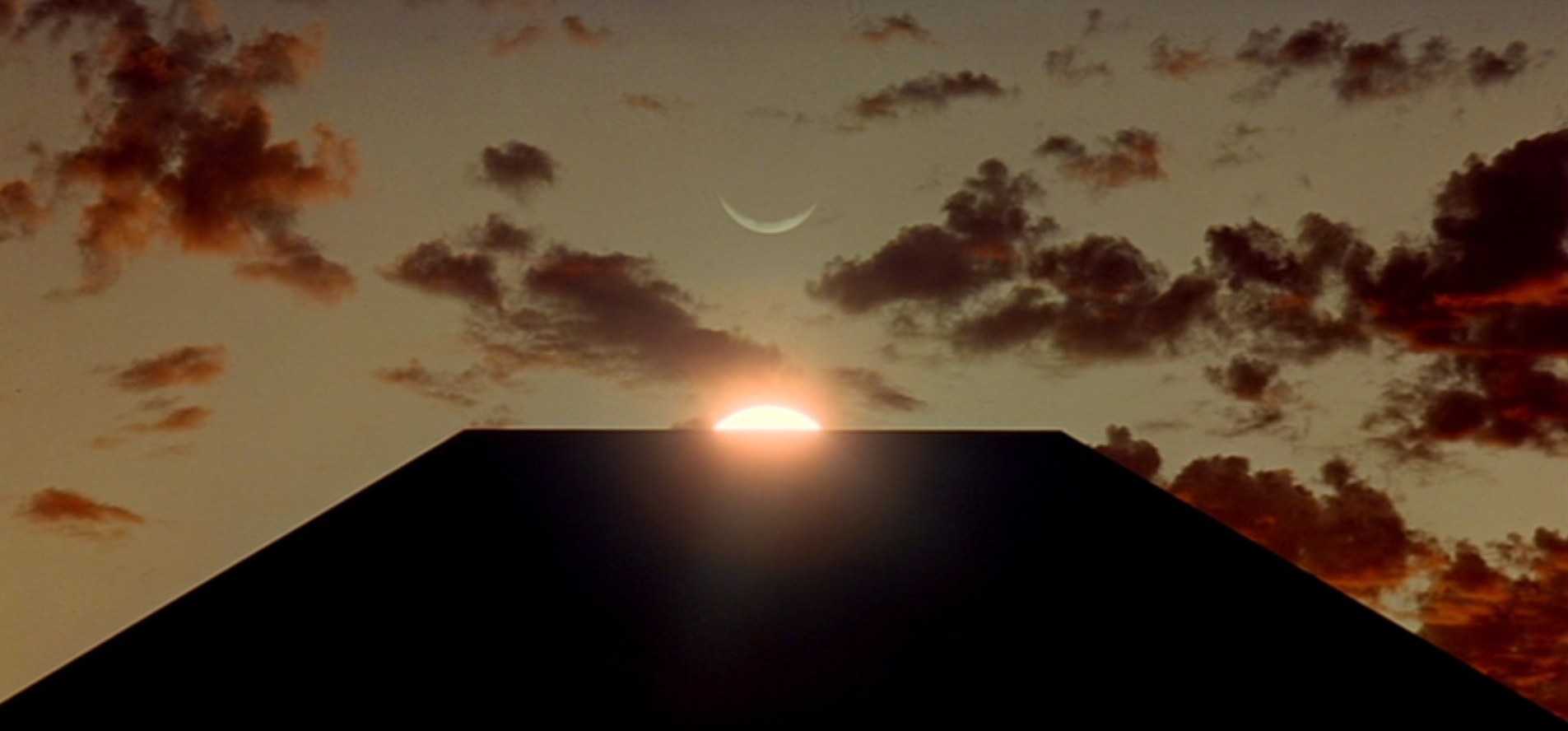
Go to TOC for this film ( (which has also a statement on purpose and manner of analysis and a disclaimer as to caveat emptor and my knowing anything authoritatively, which I do not, but I do try to not know earnestly, with some discretion, and considerable thought).
Keir Dullea - Dr. Dave Bowman
Gary Lockwood - Dr. Frank Poole
William Sylvester - Dr. Heywood R. Floyd
Daniel Richter - Moon-watcher
Leonard Rossiter -Dr. Andrei Smyslov
Margaret Tyzack - Elena
Douglas Rain - HAL 9000
Stanley Kubrick and Arthur C. Clarke - Screenplay
Gerald Fried - Music
Geoffrey Unsworth - Cinematography
Ray Lovejoy - Editor
John Hoesli - Art Direction
USA release date 2 through 4 April 1968.
For complete listing see IMDB.
This work was released four years after Dr. Strangelove, putting Kubrick at about forty years of age.
TOC and Supplemental Posts | Part 1 | Part 2 | Part 3 | Part 4 | Part 5 | Films Home
LINKS TO SECTIONS OF THE ANALYSIS ON THIS PAGE:
Headings/subheadings and some subjects covered:
The Eternal Return, Shots 1 through 2
Commentary included with the screengrabs. Gyorgy Ligeti's "Atmospheres". Richard Strauss' "Thus Spake Zarathustra" inspired by Nietzche's. The sunrise section. Nietzche's conception of the eternal return. Kubrick's repetitions.
The Dawn of Man, Shots 3 through 105
Commentary included with the screengrabs. Among those things examined: The use of still photography. The hominids presented in Museum of Natural History diorama-like settings which show often a kind of vignette of brush-like vignette effects. The effect of this. The inability to largely identify the opposing bands from one another (refer to opening of Fear and Desire and the use of doubling). The repetitious use of a sunrise image, also for a seeming sunset.
The Monolith and its Symbolic, Unnatural Conjunction
Ligeti's Kyrie Eleison from his Requiem. The monolith occurring with a once-reversed shot (55) of the previously used sunrise shot and clear examples of this. Return to "proper" orientation in shot 56. Comparing the foreground in shots 46 and 56 with shot 439 in The Shining, the one from behind Jack, he in silhouette as he suddenly appears after Wendy has read his writing. The impossible alignment of the sun and moon above the monolith which means it is symbolic and represents perhaps the "hour of noon" in Neitzche's writings. Sample given. Examination of memory in relationship to the primate killed by the panther. Shot 105 of the thrown bone which revolves counter-clockwise ascending and then briefly is out of view and when we see it again still ascending it is now moving clockwise.
SKIP ALL THIS AND TAKE ME TO THE TL;DR WRAP-UP AT THE END OF THE PAGE.
0 Intro screen and music. (:09)
Black screen with intro music. Gyorgy Ligeti's "Atmospheres".
1 The MGM lion (3:00)
"Thus Spake Zarathustra" begins.
2 Return to the black screen. (3:11)
At about 3:17, as the horns enter, the upper hemisphere of a blue celestial body fades into view. The camera rising, we see a view of the Earth between the distant sun and the foreground dark of the moon which continues to lower in the foreground as the distant sun rises above the Earth.
It may be, with the way the sun, earth and moon are lined up, that they are in position for a lunar eclipse.
At 3:52, the moon having lowered so it is out of frame, we have the credit METRO-GOLDWYN-MAYER Presents. At about 3:59 the credit leaves the screen.
4:02 A STANLEY KUBRICK PRODUCTION. To 4:06.
4:11 2001: A SPACE ODYSSEY appears on the screen as the sun begins to clear the earth then ascends above. About 4:28 begins a fade to black that is completed by 4:30. The music continues to about 4:34.
We can't overlook the significance of the use of Richard Strauss' Also Spake Zarathustra during the "Sunrise" section, Strauss' composition inspired by Nietzsche's Thus Spake Zarathustra. A central idea to Nietzsche's work was the eternal recurrence, its inspiration experienced by Nietzsche during a walk when he saw a pyramidal block of stone in the alps at Lake Silvaplana. Wikipedia shows a picture of the stone, and when I look at that stone, its pyramid shape, with the lake beyond, the mountains around, I wonder if it also became an inspiration for the opening of The Shining. I write about this in a separate post.
Another central idea of Nietzsche's work is that of humans as a transitional phase between apes and superhumans--the notion of the superhuman, of course, becoming an influence on Nazism, though Nietzsche (d. 1890) was himself said not to be anti-Semitic, and was a critic of German nationalism.
The cyclical, recurring nature of life that Nietzsche proposed appears to have been one locked into a perpetual reconstitution of things so there is no deviation.
What, if some day or night a demon were to steal after you into your loneliest loneliness and say to you: 'This life as you now live it and have lived it, you will have to live once more and innumerable times more' ... Would you not throw yourself down and gnash your teeth and curse the demon who spoke thus? Or have you once experienced a tremendous moment when you would have answered him: 'You are a god and never have I heard anything more divine.'
Also...
"Whoever thou mayest be, beloved stranger, whom I meet here for the first time, avail thyself of this happy hour and of the stillness around us, and above us, and let me tell thee something of the thought which has suddenly risen before me like a star which would fain shed down its rays upon thee and every one, as befits the nature of light. - Fellow man! Your whole life, like a sandglass, will always be reversed and will ever run out again, - a long minute of time will elapse until all those conditions out of which you were evolved return in the wheel of the cosmic process. And then you will find every pain and every pleasure, every friend and every enemy, every hope and every error, every blade of grass and every ray of sunshine once more, and the whole fabric of things which make up your life. This ring in which you are but a grain will glitter afresh forever. And in every one of these cycles of human life there will be one hour where, for the first time one man, and then many, will perceive the mighty thought of the eternal recurrence of all things:- and for mankind this is always the hour of Noon".
I am less concerned with Nietzsche's conception of what all this exactly meant for him than Kubrick's intentions in use and repurposing of the eternal recurrence, for Kubrick's works are all about the conflict of predeterminism (the oracle) and free will, and repetition as found in ideas concerning anemnesis and ZKR. His usage of deja vu, characters often revisiting situations, is all an expression of this, the traversing of the duplicate or similar patterns of a maze or labyrinth in the journey to the center. So, though Nietzsche writes of a locked-in life, and we need to have an understanding of Kubrick's references, Kubrick's use of these ideas must be considered in context of his expression of certain themes throughout his oeuvre and how he played them out.
The Dawn of Man section is a part of the film that is very easy to be taken simply and without examination as it seems baldly, plainly told. The hominids lose the waterhole. The monolith appears. Hominids learn how to use tools and kill for food and defence. They retake the waterhole. But there is more going on in these shots than that surface story. We need to question what we are really seeing as opposed to what we believe we are seeing and have been told we're seeing.
3 Fade in from black screen to a sunrise. (4:40)
The screen still black, we hear bird song. By 4:42 the pre-sunrise dawn has faded in. The sky is a brilliant orange-crimson and the land still in shadow.
At about 4:50 the title THE DAWN OF MAN. It fades out about 4:55-4:56.
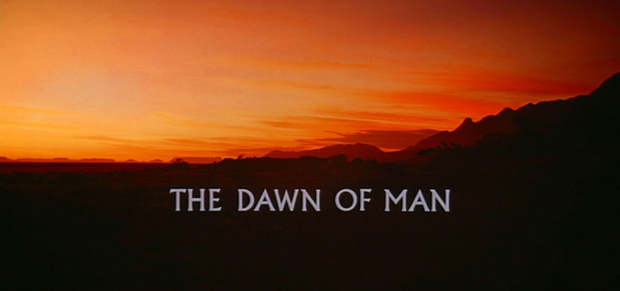
4 A view of the pre-sunrise dawn. (4:56)
5 Sunrise. Same landscape as 4. (5:02)
Shot 5 is the same shot as in 4. Rather than holding and filming the sun rising to 5, Kubrick had his on location crew shoot stills. So Kubrick cuts to the sun now already cresting the furthest left of two distant hills. Its light appearing, the rest of the landscape is now black.
6 Sunrise over another landscape. (5:07)
The savannah again. The sun is now center screen and fully above the horizon, which is a different landscape view from those former. A high hill is on the left and low hills on the right. This, too, is a still shot, as are all the on location shots. We've a nice pyramidal inversion effect of the sunlight across the savannah beside the pyramidal hill.
7 Another POV of 6. (5:11)
Another POV of shot 6, the same tall hill on the left, only now it is above the mid horizon line whereas before it was below, and though sunrise yellow sheens the sky, the sun is no longer center stage, and isn't in view at all.
8 Sunrise, a new POV. (5:17)
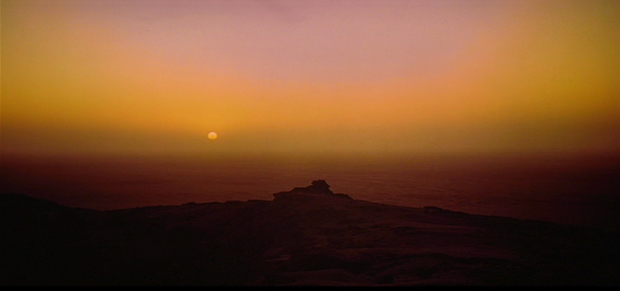
Now we view the distant sunrise from atop a seeming plateau, looking over the dusty red landscape toward the sun. Again, a still shot. We hear the sound of wind enter.
9 The savannah. (5:23)
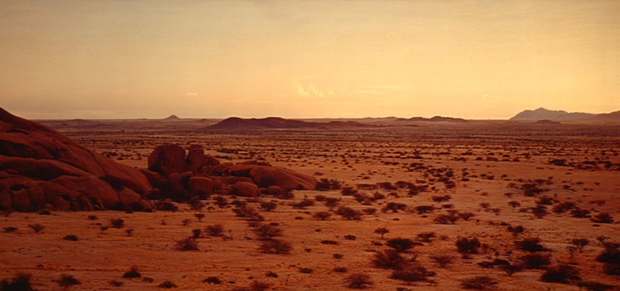
The savannah, a rocky hill to the left, hills protruding from the flat land in the distance. The earth is still red with the sunrise, though we don't see the sun in this view. Again, a still.
10 The savannah from another angle. (5:33)
We view the savannah from atop a low hill, looking across the plain at rocky protuberances. The sky is a pale pink-orange hue. No sun.
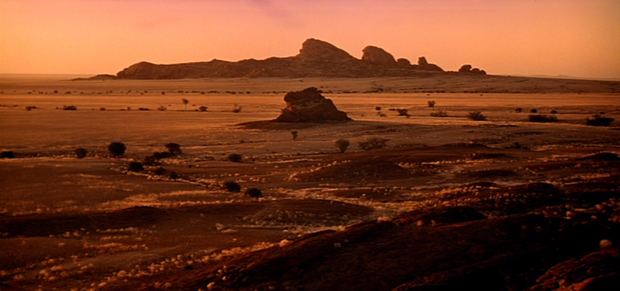
11 View of the dawn from a rocky pinnacle. (5:36)
The camera looks partly through a rock arch at the dawn sky that has begun turning to blue, the clouds a soft pastel yellow-rose. Again, a still.
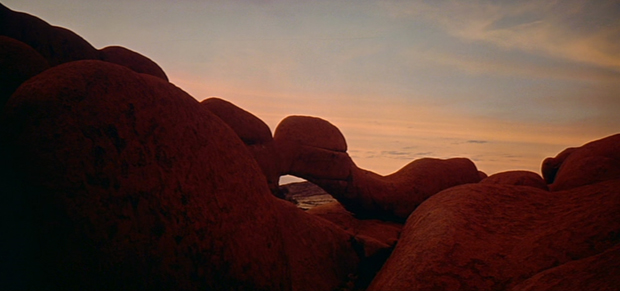
12 View of the orange-brown savannah from the top of a rocky hill. (5:44)
At the beginning of this shot we see no sky, only the savannah. Again, it's a seeming still shot but we have movement with the pan of the camera from looking down the rock hill to the savannah to looking across its seeming near lunar waste barren. At the end of the pan, the far horizon and a shard of pink sky comes into view. We hear wind. A bird.
Kubrick has chosen a semi-arid desert landscape that seems mostly inhospitable to life. What he doesn't show us is lush greenery, and so it will be for the whole of the film.
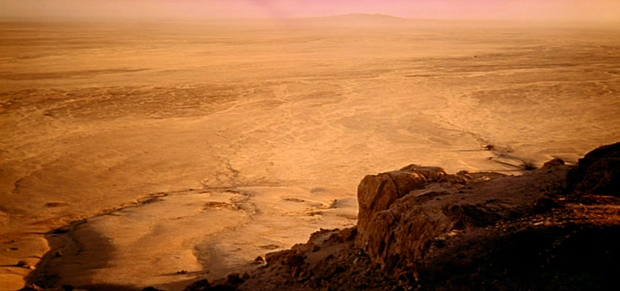
13 Tusked animal skeleton. (6:06)
Life has been the heavenly body of the sun and its interplay with earth, which provides a long sense of time. That long sense of time dramatically shortens with a view of a tusked animal skull in the right foreground, round rocks on the left, a rocky hill beyond, and just left of center in the sky is a pale sun hovering in the light blue sky. We had heard bird song, but had not seen flesh, and still do not see flesh that requires nourishment. Instead we see death in this highly organized arrangement of form required for mobile, sentient interaction with the elements.

14 Hominid skeleton. (6:12)
A rocky, more mountainous landscape. In the foreground, in shade, is a hominid skeleton stretched out on the rocky soil beside a tapir skull. The shadows from the sun rise extend from left to right. We are viewing south.
This is our first front screen projection. The tusked skull shot prior, which I think is a location still, leads into it, moving from a real landscape to a staged illusion of landscape. The sky is not clear but is textured.
15 Action shot now of two hominids. (6:18)
The two hominids, in foreground shadow, beside a large rock, are eating, sitting back to back, the one on the left in profile. The one on the right appears to be perhaps digging for roots, and then also eats. This is the life of sentient flesh, its days preoccupied with food seeking.
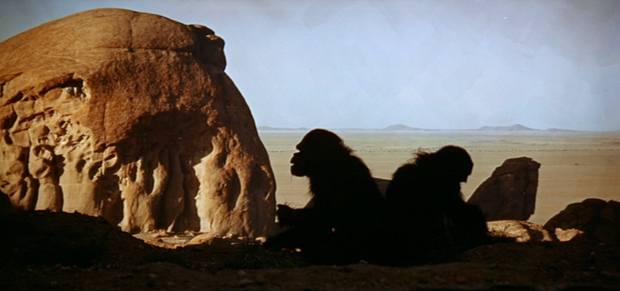
When Kubrick finally shows the hominids, he fixes them solidly in a sense of reality by having them in shadow against a front screen projection that shows not just distant background but also a large foreground rock that is part of the front screen projection image, but beside which the hominids thus appear to be seated. With our not being visually introduced to the hominids straight-away, seeing them first in shadow, the edge is taken off the confrontation of our meeting them in full light. Jump down to shot 17. If we first had seen the hominids as in shot 17, without this intervening shot of them in shadow, seemingly beside this lively rock (which is actually not next to them), we would be less accepting of them as "real" and more likely to relate to them instead as humans in furry suits.
16 6 tapirs on the savannah, hills beyond. (6:25)
Having made the hominids feel to us as though they are on location rather than on an artificial set, Kubrick now shifts to a very painterly combination of stage and front screen projection. The center tapir stands still for most of the shot and so we feel as if we are looking at a painting that is partly coming to life, or as if we are viewing a diorama at a museum of natural history.
Though Kubrick has striven for a great sense of reality, he then murks it up. The skies of many of the front screen projection images (not the introductory sunrise stills) have been played with so they have darkened edges, a hint of vignetting, and a kind of of cross-hatch effect that almost simulates the brush strokes in a painting.
I have read the 3M material on the great screen used for these projections, laid out in sheets, ended up showing a seam, and to eliminate this Kubrick had the material layered on in various shapes in such a way that no seam ended up being shown. This layering of the 3M materials in different shapes doesn't appear to be the reason for the seeming simulated brush strokes that are different in every shot. I may be wrong, but these texture effects appear to have been applied to the images themselves. So Kubrick again goes to great lengths for a sense of reality and then imposes a filter that distances us from that reality.
17 A tapir beside three seated hominids. (6:31)
A tapir nonchalantly shares the landscape with three hominids. The hominid on the left digs in the rocky soil for roots. One on the right is reclining while another grooms it. The hominid on the left barks at the tapir to get away, protecting its food source.
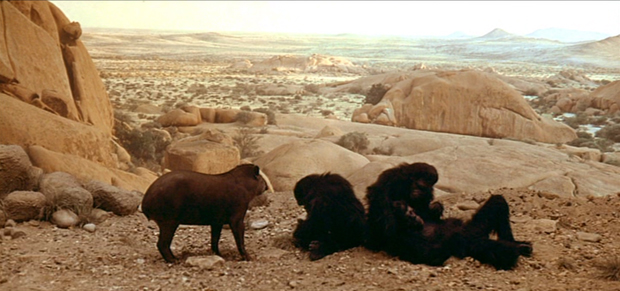
A lot of time and money went into making these hominids appear as realistic as possible, but nothing was going to make them appear absolutely natural. We just instinctively know better. Our eye knows better. So Kubrick first introduces the hominids in shadow (shot 16) and then he removes the hominids from a realistic framework and presents them in what is like a museum of natural history frame, on a museum of natural history stage. The use of stills in the opening shots, rather than film, also helps ease that process. We don't have natural movement in those stills, the vibration of air that seems to reside in motion pictures that examine a seeming unchanging setting. Which is what makes this recreation of a deep, archaic, primordial past work. We have extractions out of time in the stills so we aren't trying to cross the threshold into experiencing the past as "happening". We have distillations of life in these diorama type sets, a theater in which our eye and psychology is able to accept this artificial blend as real, just as we accept a good museum of natural history diorama as approximating reality rather than being foremost disturbed by its unreality.
18 4 tapirs and 5 hominids. (6:40)
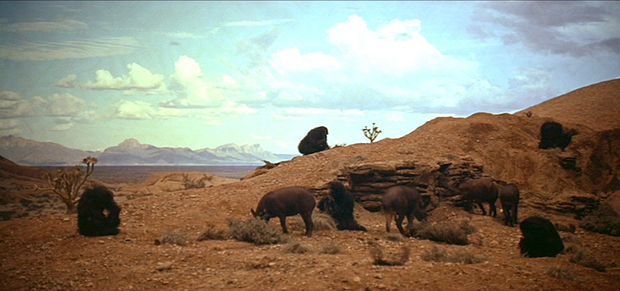
19 3 hominids (6:44)
In the close foreground shade sit 3 hominids in shade, barren rock landscape beyond. The one on the left is perched on a low rock, facing the camera, profile to the left. The two others are beside, resting on the soil. One digs about a clump of grass. The one on the rock has been examining a small bush on the rock at eye level. It tears off vegetation and eats.
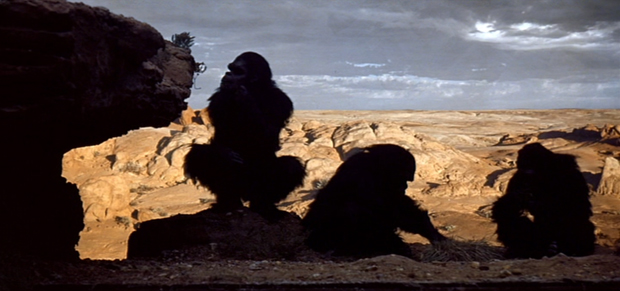
As a balance to the theatricality of the beautiful museum of natural history type staging, Kubrick returns us here to the hominids in shadow with a very lively background with rich natural sun, the kind of environment in which we'd first been introduced to the hominids in shot 15. In our first introduction there had been little movement. Now, the hominids really interact with the environment, our sense of them becoming more real. In shot 15, the lively rock at left screen had been a front screen projection. In this shot, the rock at left screen is part of the set.
20 4 tapirs and 5 hominids beside animal skeletons (6:51)
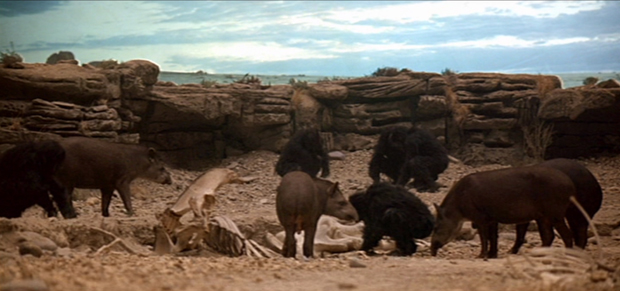
The hominids, grunting, forage about the earth in a communal group.
21 5 hominids and 4 tapirs beside another animal skeleton on a hill. (7:01)
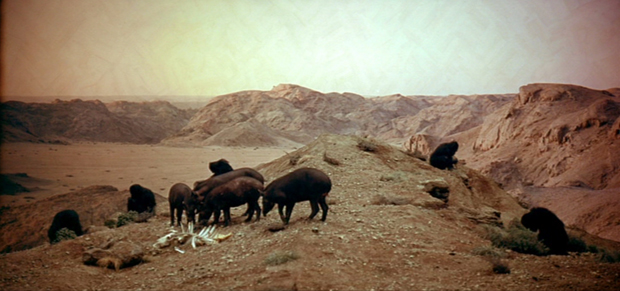
The 5 hominids, though still communal, rest apart from each other, silently foraging near short bushes.
We are still getting into a "plot line" of the hominids, and many of these initial settings in which we see the hominids aren't later repeated, such as this one, or the sets of shots 14, 15, 17. However, we were just shown in shot 20 a set that will be repeated several times, yet we have then this cut to shot 21 that takes place on a set that won't be repeated. This disorients the viewer as they try to establish their bearings and the "place" of the hominids in the setting. That disorientation of including sets that won't be repeated means that when we see sets that are repeated the story line that's building is still somewhat "loose" and disconnected from them, even when we realize they're the same sets. Our focus is also split with the building story line of the interactions of the hominids with the tapirs, the aggressive movements of the hominids and the placid response of the tapirs that are not very threatened by the hominids. That's not much of a story and Kubrick has to work it to get us involved and keep us involved until he steps up the action.
22 2 hominids foraging and 2 tapirs before a rocky hill. (7:11)
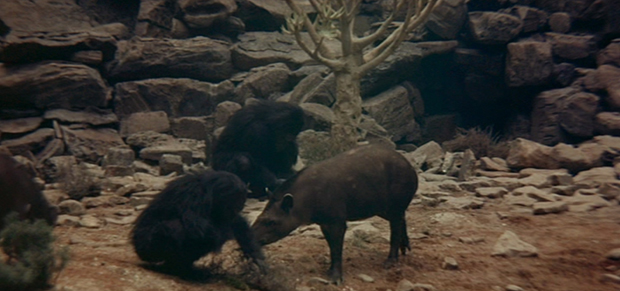
The hominid in the foreground left, vocalizing, threatens a tapir that attempts to forage from the same bush, the other hominid stopping to watch. The tapir runs a few feet off.
23 2 hominids and 2 tapirs before a rocky hill. Same area as shot 22. (7:18)

As a tapir approaches the bush upon which the right hominid is foraging, the hominid leaps up and threatens it aggressively. The other hominid joins in this time in the vocalizations. The tapir is not much impressed but turns away.
Shots 22 and 23 are in the same area but we have not been shown a panorama shot of this yet and so don't know this, we have only perhaps an idea it is in the same area through the similarity of the rocks and vegetation. We won't see a panorama of this area until shot 43, when it will be at night and because it is dark we won't be confident it is the same area. Not until shot 85 will we see the area in panorama in daylight.
I should add that in this shot we finally we see some green herbage in the background, but we won't really notice it because it is so much in the background and also because other settings, without green, will sometimes have a greenish sky tint. With the exception of a couple of shots, such as this one, Kubrick's hominids have little relation to a green, verdant earth. After humans leave earth, we will only view one photo, barely glimpsed, of a green earth landscape. The most green we will see will be that depicted in the paintings in the hotel-like room beyond infinity.
24 5 hominids and 3 tapirs on a mostly barren hill, mountains beyond. (7:25)
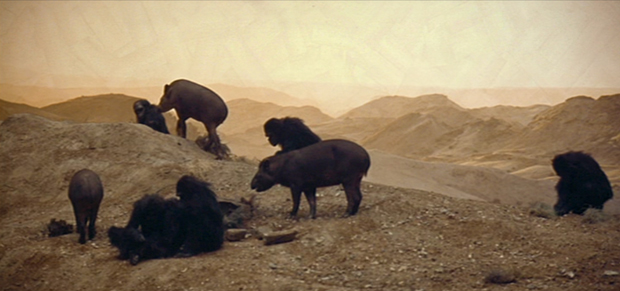
The two foreground hominids sit together, one grooming the other. The three others sit apart, foraging.
Again, Kubrick has taken an area where we will have repetitive activity and has followed it with a shot of an area we will not see again. Shot 24 looks very much like shot 21, where Kubrick did the same thing, showing an area where we will have repetitive activity and following it with a shot of an area not seen again. Though shots 21 and 24 look much alike, they don't show the same scene, at least not from any familiar vantage.
25 6 hominids forage near bones at the base of a rocky hill. It seems to be near sunset. Same area as shot 20. (7:32)
As they forage, a previously unseen panther leaps from the hill and upon the left foreground hominid, which screams and wrestles with it, the other hominids taking notice and beginning to flee to the right. The hominid briefly escapes the panther, which again leaps upon it. A quick fade to black at 7:47. We continue to hear the roar of the panther and the scream of the hominid.

This is the climax of our first story line concerning the hominids. They feed along with the competitive tapirs who are not in the least afraid of them. Rather than predators, the hominids are instead hunted. Vulnerable. The panther attack completes that part of the story. A hominid is perhaps killed, though we don't see it killed on camera, while the others flee in the background. We have no clue which hominid was killed because they all pretty much look alike and it doesn't seem to matter much as we have been and are experiencing them as a collective, but here Kubrick also brings in the story of the individual. The isolated hominid, the one who is left alone while the others flee, becomes exceptional, more human even, because we automatically assign to it a back story, even if that back story is as concise as this-is-the-doomed-hominid. To recognize a creature as fat out of luck is to give it character. Otherwise, the creature is just plain food.
26 Crossfade from black to a group of hominids sitting beside a water hole in a hill area composed of rocks, savannah and blue sky beyond. Day. (7:55)
In the left mid-foreground sit 3 hominids. Just right of center screen is the water hole with 4 hominids sitting about it. 3 other hominids sit mid-foreground to the right. Silence but for birds.
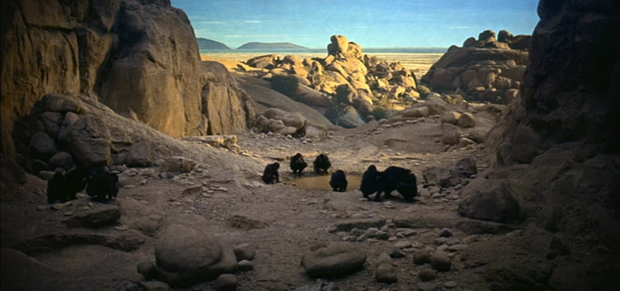
Kubrick begins the second story line in an entirely new setting around a water hole.
27 4 hominids sit pressed together. (8:00)
They forage and groom, one vocalizing. This perspective shows the same landscape we will view in shot 32 though from a greater distance.
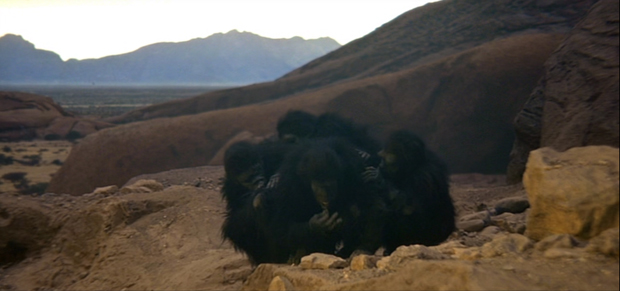
28 A hominid foraging in the seeming barren earth, other hominids nearby. It vocalizes. (8:04)

29 MCU of a hominid at the water hole, 3 others in view. (8:07)
The central hominid vocalizes, as then do the others. It turns on a hominid to screen right, chasing it away, then returns to drinking.
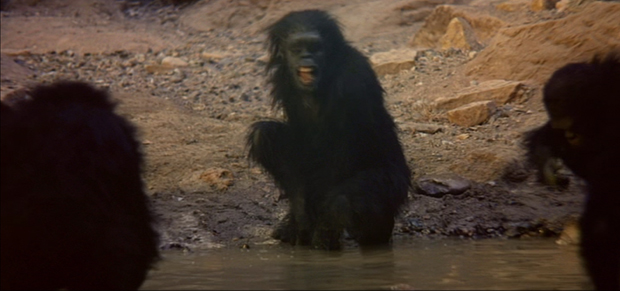
30 MCU of hominid couple at the water hole, female grooming the male. (8:19)
Other hominids loiter about but the camera is concerned with this center pair. The male leaps away to the left, the female vocalizing.
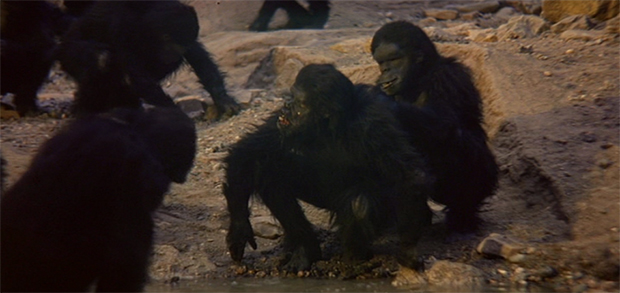
31 5 hominids about the water hole. (8:22)
One hominid moves off to the left while the other four remain about the water hole.
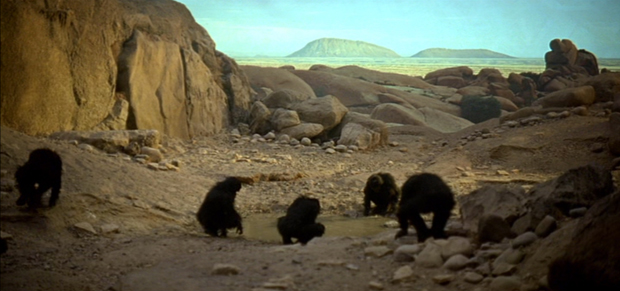
32 View of the water hole and hominids about it from above and beyond a rocky hill over which scales another hominid. This is the same landscape view as shot 27 but much further removed. (8:27)
The hominid sneaking up the hill pauses, two others following.
33 The water hole with 3 sitting about it and about 8 foraging in the barren earth beyond. (8:38)
Essentially the same view of the water hole as in 32 but without the foreground hill over which the invaders creep.
An off-screen sound attracts the attention of those about the water hole. They look up and begin screaming.
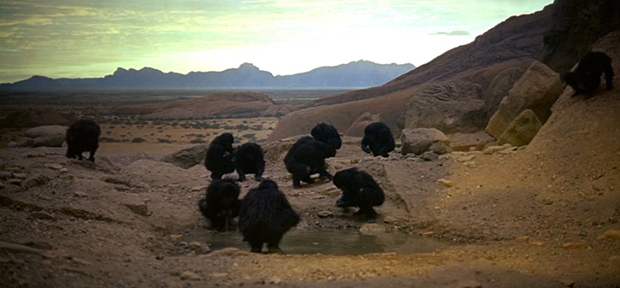
34 Opposing view of the water hole with the hominids about it facing the other group as they ascend the hill, the savannah in the background. (8:43)
35 Medium shot of the invading hominids approaching the waterhole. (8:54)
I may as well go ahead and say now that I've never been confident that the man (or at least the mask) that plays "Moonwatcher", isn't the leader of both gangs of hominids. It's common knowledge now that Moonwatcher is the leader of the group that is being run off and that it is he who will have an epiphany following the encounter with the monolith. But compare shots of the leaders and they look very much alike, such as compare this shot with 29. Very much the same build, brow, set of eyes, mouth, hairline at the forehead and then there's the scant hair on the right knee. If they are the same individual (David Richter) playing the leader of both groups, then that returns us to Fear and Desire in which we have a group of soldiers who crash behind enemy lines, and the Lieutenant and a private end up confronting themselves playing respectively the enemy general and captain.
36 Shot of defending hominids across the waterhole. (9:09)
37 Medium shot of the defending hominids leaping and stamping their feet in rage. (9:17)
38 The invading hominids. (9:19)
They enter the waterhole and chase the others off.
39 The failed, defending hominids from behind the invaders. They leave, beaten. (9:34)
40 The invading hominids surround the water hole. (9:39)
41 Medium close-up of the invading hominids beginning to drink. (9:49)
Fade to black at 9:57.
This encounter at the water hole is the beginning of our second story line, though it seems at this point to be at an end. Both bands of hominids look so much alike that we could scarcely have any preference for the ones initially surrounding the water hole. Eventually, our sympathies will be with that first occupying band, that was run off, as we learn more about them, but without that that story, we really shouldn't care which band wins, though sympathy naturally is often accorded the occupying resident that is run off. At this point, we don't even know if that resident band is the one we had previously seen in the film. We don't know if the band resident at the water hole is the one that had been attacked by the panther. We can only assume at this point that it is the same band.
Shot 36 | Shot 39 |
 |  |
Shot 37 | Shot 40 |
 |  |
Shot 38 | Shot 41 |
 |  |
The above table of photos isn't to show an internal organization of shots but to give an idea of how little info we are given as far as telling the two bands of hominids apart. The only individual hominid to stand out is the leader of the gang that takes over the waterhole.
42 Fade in on evening, the sun setting across the savannah. (10:04)
Kubrick has briefly returned us to a still shot of a natural landscape.
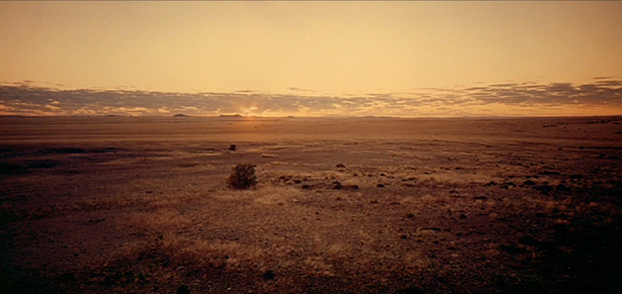
43 View of rock hill that was seen in 22 and 23. Tapirs and hominids are absent. We hear a panther's roar. (10:06)
After the battle between the two groups of hominids, we may even begin to see in what we take to be a random, natural pile of rocks a semblance to an artificially constructed fortification. Eventually, building with stone in certain forms is promoted by what the hominids already observe in nature.
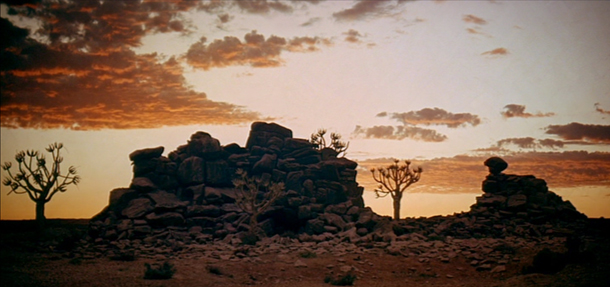
These sunset clouds are almost exactly the same sunrise clouds viewed in images 4 and 5. We will see them repeated again. We do not here see the two distant hills in the 4 and 5 stills; in this front screen preojection those hills are obscured by the rocks.
Below is shot 4, and as you can see these sunset clouds are from the same shoot as the sunrise ones. It is not the same still, but it is from the same shoot.
44 Medium shot of a panther with a zebra kill. (10:12)
All of this is supposed to be taking place about 4 million to 3.5 million years ago when the diet of hominids changed. The panther, as an expression of its Panthera ancestor, fits the bill. The tapirs don't. They didn't exist back then and don't belong to Africa. Perhaps the tapir is supposed to represent an ancient animal like the warthog.
We assume the panther shown in shot 44 is the same that killed the hominid. We are struck by how its eyes flash, reflecting the light of the front screen projection. Kubrick has said they didn't know this would happen, but they certainly kept it for effect. He could have chosen to cut it out. Leaving this in adds a "weird" aspect to the panther, magnifying it into something more than a panther, while also reducing it. The panther, in some ways, seems to become individually transparent and is instead a force of nature, of primal forces as a whole, through its being united with the light in the background. As the eyes of the hominids don't ever do this, they continue to relate to us more and more as individuals as they are now further distinguished as being more than just the collective.
The panther transcending the individual, approaching archetype, we may be more likely then to look upon the zebra also symbolically. The zebra could be just a "kill" for panther, or there is a sub-story in its markings as to the duality of nature, the yin-yang separation and interplay of light from dark. It would do well to remember this shot and consider it in future shots where we have a strong black and white theme, for this shot is a singular one in the Dawn of Man section due to how the black and white and stands out.
45 Blue night. The rock ledge within which the hominids take refuge to sleep. (10:26)
We hear the panther's roar.
46 A slightly closer view of the rocky pit in which the hominids huddle. (10:35)
Again, the threatening roar of the panther.
47 Medium shot of four of the hominids, very awake and listening to the panther. (10:43)
48 Medium close-up of a single hominid huddled alone in the rock. (10:55)
49 Medium shot of 5 hominids huddled together, eyes open, listening to the roars. (11:00)
50 Medium shot from the side of 5 hominids in a huddle, also listening. (11:05)
One of the them roars in the direction of the roar of the panther. It then forages some bit of brush to eat. The hominid next to it reaches to try to take it or a bit of it and the hominid barks back in protest. Again, the panther roars and all fall quiet.
51 Medium long shot of the hominid seen in shot 48, and this time we also view what presents as a family, two hominids to the right, listening, eyes open, one of them holding a child. (11:27)
52 First close-up of a face of one of the hominids. Its eyes dart back and forth, listening to the roar. (11:36)
What these shots of the members of the collective does is to individualize them, even as small groups. Their fear becomes more personal. We are finally shown their eyes up close and blood shot. They are argumentative but also restrain their aggressive behavior. They console each other. Their anxiety becomes intimate and they become more our ancestors, fearful, stressed out, haunted all night by their bills and awareness of their mortality.
Shot 47 | Shot 50 |
 |  |
Shot 48 | Shot 51 |
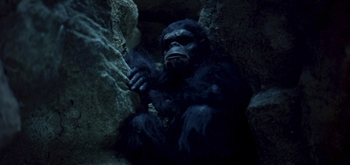 |  |
Shot 49 | Shot 52 |
 |  |
Reviewing the above in a table we see an internal organization that might escape the eye otherwise. The hominids in shots 47 and 50 are not the same grouping but one distinctly recalls the other, each group huddled to screen right in a like manner. The hominid in shot 48 appears again in shot 51 but the color temperature of shot 51 takes after shots 50 and 52. The hominid in shot 52 could be out of groups 47, 49 or 51. What makes it stand out is the final close-up of the anxiety of the individual.
It isn't by chance that we have prior this sequence a shot highlighting the peculiar eyes of the panther and then have this sequence end with a close-up on the face of the hominid and of its watchful, terrified eyes. The panther is a force of nature. The hominid is suggested as having slipped the bonds of nature in its canny, self-aware terror of nature.
53 Orange-red sunrise. We view a thin sliver of moon high in the sky. (11:40)
Fade to black at about 11:43.
54 A huddle of hominids sleeping against the rock, the sun shining upon them. (11:51)
We hear Ligeti's "Kyrie Eleison" from his Requiem, a mass for the dead in which it is asked the deceased be granted eternal rest and the perpetual light of God to shine upon them.
The "Kyrie Eleison" is "Lord have mercy; Christ have mercy; Lord have mercy."
Divine mercy is begged as well in the beginning of Clockwork Orange with the use of the "Funeral Music for Queen Mary", and in The Shining with the use in the opening of "Dies Irae". One wonders at the use of the Requiem's "Kyrie Eleison" here, but it's to be remembered that one of the hominids was killed by a panther in shot 25, that Kubrick revisited the big cat in shot 44 and that he has filled the night with the roars of the feline discomfiting the hominids and filling them with fear. An expression of mercy would certainly be had in the gaining of freedom from that anxiety in an evolutionary leap involving the realization of weaponry. Which is about to happen.
One of the hominids, waking, grunts and barks in anxiety, staring at something off-screen, which we will in a moment see is the monolith. It stamps its foot finally to rouse its fellows.
55 The monolith seen against the impending sunrise. (12:24)
These are actually the same clouds and hills in shots 4 and 43 only flipped horizontally. Below is shot 4, how they were originally viewed.
Below I take shot 4 and flip it horizontally so it is the same orientation as 55. Recollect that the same cloud scene in shot 4 was the same as in shot 5 only in shot 5 the sun had begun to rise above the twin hills. The reverse orientation is important and Kubrick makes use of it several times in 2001. This is the first example, occurring with the revelation of the monolith.
Here again is the same cloud scene in shot 43. Horizontally flip it in your imagination and these are the same clouds as in shot 55.

If we compare the night shot from 45 to this morning one in 55, we see we have in each exactly the same foreground scene. If you layer the two over each other, all the foreground elements are the same. But in shot 45 Kubrick used a different front screen projection for the background, so the two hills seen in shot 55 aren't observed in shot 46. You can make this out more easily in the screengrab of 45 I've lightened below
If we lay shot 45 over shot 55, how they overlay perfectly except for that change of the landscape in front screen projection is observed with the two hills.
I stress these background differences because they mean a physical difference in terrain that shouldn't be as there has been no change in perspective, and Kubrick could have made modifications so this problem wasn't presented. But, principally, I am concerned with how we have a horizontal flip of the front screen projection.
The front screen projection for night shot 45 has a break in the clouds that approximates where cloud is positioned in shot 55.
The source of light illumining the area at night, where the monolith will appear the following morning, is eerie, seeming to anticipate the fantastic monolith and setting a stage for it.
Kubrick had sent a film unit down to Africa for still shots and you know that they came back with more than a couple of sunrises from which to choose for his front screen projections. Kubrick wasn't sitting there saying, "Darn, I've only got a couple of sunrises that I like. Maybe no one will notice if I use them again, again. Maybe they'll look different if I flip them around." That isn't why he used these shots over and over again. That isn't why he used a horizontal flip.
The hominids flow out of their hiding place and gather in a circle round the monument, screaming and barking in excitement.
56 Medium shot of the monolith and the hominids leaping about it. (12:41)
One leaps into the pit and after several approaches he briefly touches the monolith. This hominid is identified as Moonwatcher in the script and other materials, otherwise we wouldn't know it as Moonwatcher.
In shot 56, the clouds are the same as those in 55 but have been flipped back to the original orientation as observed in shots 4 and 5 and 43. Again, here is how the scene looked in the preceding shot, 55.
This may seem insignificant now, these reversals, but they continue throughout the film and are thematic for Kubrick and serve a purpose.
Now, back to shot 56.
This shot is from the same view as shot 46 and is an interesting one as Kubrick has us peering out from around an embankment so one almost has a sense of spying upon the hominids. Let's examine shots 56 and 46 beside one another.
I will go ahead and note how a piece of a center rock, seen partly obscuring the hominids in the night scene, has been sheered away for the placement of the monolith. If one overlays the shots one can see how this is so. But that's not what I'm looking for in comparing these two shots. What attracts notice for me is how much the foreground right rock in shot 56 is like the background left cliff ledge, of which we have a very good view in shot 55. It could almost seem the same in reverse, though it is not. Their imposing lines balance the scene, providing a certain symmetry. With this sense of mirroring, the monolith occupies a center area between them.
The obstacle of rock on the right, close to the camera, personalizes our view, placing us on a more intimate level with the subject. We almost have the feeling of spying around it at the hominids. Off the top of my head, with the exception of another scene in this film, when HAL is reading the lips of Dave and Frank, I can think of very few times Kubrick gives us this sneaky immediacy. The one that does pop immediately to mind is in The Shining, after we've had Wendy viewing Jack's writing in the typewriter, a couple of those shots done so the typewriter resembles the monolith during the sun and moon conjunction scene in shot 58 of 2001. After Wendy's horror at viewing what Jack has been repetitively typing, with minor variations, Jack abruptly appears from the rear of the Colorado lounge, and his figure is in 3/4 silhouette from behind, so that it greatly resembles this front right rock in 2001 from around which we watch the hominids with the monolith. The surprise of the hominids is focused on the monolith that has appeared in the middle of their pit. Wendy too is surprised by what was found in the typewriter, but then her surprise turns to Jack appearing out of the shadows of the area before the elevators, where she had previously checked and had not seen him. His shadow steps forward out of nowhere.
This silhouette of Jack was of such significance to Kubrick that it was presaged in the film throughout the initial phase of Dick's drive up to the overlook. Shots of Dick in silhouette on the left, mirror Jack on the right as he emerges from the shadows. This mirroring, though in separate scenes, reminds of shot 56 and how the front right rock mirrors the left rear cliff.
It's a very threatening image in The Shining, Wendy's world upended by Jack's novel being only one phrase typed over and over again with variations in form. That repeated phrase brings us back to the idea of the eternal recurrence which I wrote of at the beginning of this section as per it being introduced with the sunrise musical selection in which Strauss was inspired by Nietzsche's Thus Spake Zarathustra.
Just as the monolith initiates the ability to adeptly and reliably kill for food and self-defense in 2001, so will Wendy now succeed in using her bat to defend herself against Jack. These two scenes are intimately bound together.
As for the monolith itself, the wonder it inspires in the hominids, one of the points of it is that it displays perfect symmetry by design in its proportions, something one does not associate with the views of nature Kubrick is presenting us, except that mirroring symmetry is hinted at in these opposing rock faces and a certain mirroring symmetry is created in the horizontal flip of the front screen projection landscape in shot 55 when the monolith appears.
57 Closer shot of the monolith, the more adventurous hominid and a second with it in the pit. (13:23)
Several other hominids now join those already in the pit. Again, the more adventurous hominid touches the monolith and the others finally follow suit, all exploring.
58 The moon and sun rising over the monolith. (14:28)
The vanishing point established by the monolith occurs just below the bottom of the crescent moon.
The film had opened with the alignment of the audience, moon, earth and sun.
In shot 53, before the hominids awoke to the monolith appearing in their midst, we'd been shown a sliver of moon in the sky.
Now we've an alignment of the monolith with the sun rising above it in combination with a waning moon. It's an impossible combination, isn't it? The waning moon in the northern hemisphere shows light on the left, whereas in the southern hemisphere it is on the right. I would have wondered if the stills were taken for that shot at about the equator or above for as seen in image 53 we have the waning moon with light on the left, but I read the 2nd unit African crew was in Nambia. (Is shot 53 reversed?) In shot 58 we instead have the moon in a U shape with its horns pointed up. I suppose rather like a spring moon. That moon is close to the sun which appears to be more a noon sun high in the sky, above the monolith, while the clouds belong to the sunrise.
Which is impossible.
What we're seeing is an unnatural phenomena--one can't, of course, have a noon sun and a sunrise sun at the same time--and so this is instead an expression of a state of enlightenment for the hominids and not to be taken literally. This closely correlates with Nietzsche's writings of the "hour of noon" as always being the state of enlightenment of the eternal recurrence.
And in every one of these cycles of human life there will be one hour where, for the first time one man, and then many, will perceive the mighty thought of the eternal recurrence of all things:- and for mankind this is always the hour of Noon.
With the moon's horns pointing away from the sun, I am reminded more of symbolism concerning Taurus, the bull, and various horned deities.
59 Long shadows over the savannah. (14:35)
60 Rocks before the savannah. (14:41)
61 Rocks and hill before the savannah. (14:45)
Shot 60 | Shot 61 |
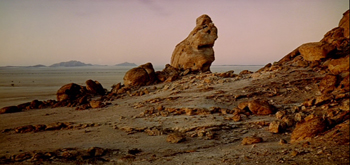 |  |
We have shots that again reset us in the illusion of reality, however still, before we return to the museum of natural history theater.
62 Same area as shot 25 where the panther attacked the hominid. (14:50)
A hominid, Moonwatcher, enters from the left and sits before a bunch of bones. If we compare this to shot 25 (below) when the panther attacked the hominid, we see that Moonwatcher enters from the same area to where the hominid, attacked by the panther, was struggling to flee, and that part of their struggle occurred on the same ground where Moonwatcher sits.

We also see that Kubrick is using, in shot 62, the same front screen projection as in shot 25, the color having been changed slightly to be less green. The bones on the ground in shot 62 are the same as in shot 25. Shot 25 began with several other hominids in the background who fled when the panther attacked, and as Moonwatcher sits and examines the bones, the other hominids in the background again exit, making this a private revelation for Moonwatcher. With the others leaving, I would wonder if it's being suggested that this revelation Moonwatcher will have is as dangerous as the panther, a parallel being drawn. But I think ultimately we are having one of the deja vu style repetitions that Kubrick uses throughout his work. Things worked out one way originally. Now, revisited, they will work out another way.
63 Medium shot of Moonwatcher sitting down amidst the bones. (15:02)
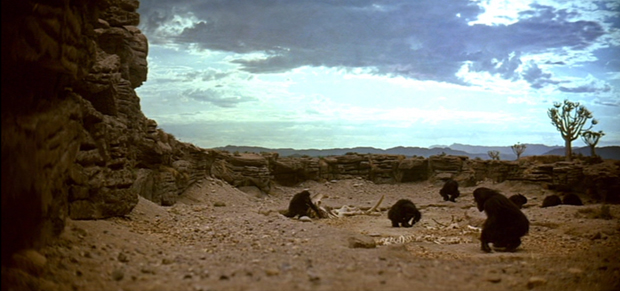
Moonwatcher begins digging, as if foraging, and the other hominids quickly depart screen right. He digs a little more then stops and raises his head in a more reflective position.
64 The monolith. (15:17)
Memory. Moonwatcher, the hominid, is recalling the past in possibly a new way, with a new sense of time, perhaps only now approaching a sense of "history" as modern humans comprehend time. He will also now have thoughts of the future intruding on the present, by means of imagination, Moonwatcher projecting and analyzing cause and effect with his envisioning of killing a tapir.
He is about to make a leap via inspiration, a eureka moment triggered.
65 Medium shot again of Moonwatcher amongst the bones. (15:19)
The "Thus Spoke Zarathustra" sunrise music begins to play again as Moonwatcher looks at, before him, the rib bones that were the same shape as the crescent moon above the monolith. He picks up a bone and begins tapping the rib bones with it, one finally flipping in the air.
He strikes the bones harder and harder, causing them to break.
66 Shot of sky. (16:15)
Close-up shot of Moonwatcher's hand rising into the sky and forcefully bringing the bone back down again.
67 Low shot from ground level of Moonwatcher exultantly striking the bones. (16:20)
He continues pulverizing the bones, finally striking the tapir skull.
68 A tapir falls to the left. (16:34)
69 Close-up of Moonwatcher's exultant face. (16:36)
He begins to raise the bone again.
70 Shot of sky and close-up of Moonwatcher's hand raising the bone against the sky, bringing it down... (16:38)
71 Close-up of the bone breaking the tapir skull. (16:40)
72 Shot of sky and close-up of Moonwatcher's hand raising the bone against the sky, bringing it down... (16:42)
73 Close-up of the bone breaking the tapir skull. (16:43)
74 Close-up of the bone breaking bones. (16:45)
75 Close-up of the shattered skull falling to the side. (16:45)
76 Close-up of rib bones flying into the air. (16:46)
77 Close-up of the skull being shattered. (16:47)
78 Close-up of rib bones being shattered. (16:48)
79 Close-up of shattering bone. (16:49)
80 Close-up of the skull being shattered. (16:50)
81 Medium shot of a tapir falling to the right. (16:50)
Whereas shot 68, I think, represents Moonwatcher contemplating cause and effect and how the new tool can be used to kill a tapir, I believe this shot is intended to represent the actual killing, even though this is followed by another shot of Moonwatcher celebrating his epiphany.
One must also pay attention to the fact that with the appearance of the monolith we had the background flipped in reverse, and now once again we have this reverse orientation with the fall of the beast, though shots 68 and 81 are obviously different shots.
82 Low shot of Moonwatcher as he finishes shattering the bones, tosses the one he holds into the air, and reaches down to pick up the remnants of the bones. (16:54)
The music ends.
As I've noted before, I would be hard pressed to attempt to distinguish between this hominid, our Moonwatcher who has had his epiphany, and the leader of the opposing band that took over the waterhole as presented in shots 35, 38 and 41. General knowledge about the story informs us this is Moonwatcher and the other band's leader is a different hominid. However, if we had only to rely on our own eyes and no other information, there is little to distinguish these two leaders, which is significant in the setting up of the doubles/twins theme which is consistent in Kubrick's films.
Shot 66 | Shot 67 |
 | 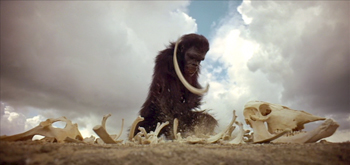 |
Shot 68 | Shot 69 |
 |  |
Shot 70 | Shot 71 |
 | 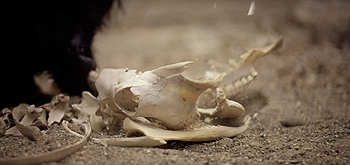 |
Shot 72 | Shot 73 |
 |  |
Shot 74 | Shot 75 |
 | 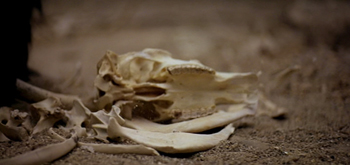 |
Shot 76 | Shot 77 |
 |  |
Shot 78 | Shot 79 |
 |  |
Shot 80 | Shot 81 |
 |  |
Internal organization of the above shots, with a few exceptions, is pretty much as expected with first the focus on the striking arm and then the object of the strike.
83 Shadows stretching out over the savannah from a hill. (16:58)
Moonwatcher enters from the left, carrying his bone-tool and also a large hunk of meat from a fresh kill. He eats.
84 Medium shot of 5 hominids eating flesh. (17:28)
None of them have bones except for Moonwatcher.
In shots 83 and 84, in which the hominids are introduced as meat eaters that use tools to subdue prey, Kubrick returns to the super-realism of background had in shots 15 and 19, before placing us in the museum of natural history type staging again.
Shot 83 | Shot 84 |
 |  |
85 Long shot of the hominids eating flesh, but this time each has a bone at his/her side. (17:33)
Moonwatcher has taught the others how to use the bones to hunt. We've returned to the same area as seen in shots 22, 23 and 43. Whereas in shots 22 and 23 the tapirs had been an annoyance foraging upon the same food as the hominids, now the competing tapir is itself food.
Whereas in shots 22 and 23 we had only seen partial and disconnected views of this site, and in shot 43 we had seen it at night, now we finally get the full panorama of this area and comprehend it as a whole.
86 The hominids in their home-pit. (17:39)
This is a return to shot 56 with the same sky and the rock in shadow to the left. There is no monolith. The hominids are eating flesh. Their home-pit now is littered with bones.
87 Medium shot of the hominids eating. (17:45)
88 Close-up of a hominid eating the flesh. (17:50)
89 Medium shot of two young hominids playing with the bones. (17:52)
Shot 87 | Shot 88 |
 |  |
Shot 89 | |
 | |
90 Sunrise over the home-pit. (18:02)
Sunrise? Or are we supposed to perceive this as sunset? Regardless, if we look closely we see movement in the shadows around the pit. The hominids aren't sequestered in it. They are able to take on the dark with their new-found weaponry.
Shot 90, above, uses for the front screen projection image the same still as shot 5, below.
These shots introduce us to the color organization we typically associate with HAL's eye.
We have the barely discernible white center encased in yellow-orange and then red surrounded by dark red.
91 Return to the waterhole. (18:07)
The shot is viewing the area around the waterhole as seen in shot 34, though we now have a medium-shot of Moonwatcher crouching on the boulders with a bone in hand, assuming a threatening posture. The opposing hominids who had earlier taken over the waterhole leap about in the foreground, while Moonwatcher and members of his group climb into view, all carrying bones.
92 Medium close-up of the opposing hominids. (18:29)
The opposing hominids have, of course, no bones.
93 Shot from behind Moonwatcher and his group, looking toward the waterhole. (18:33)
Moonwatcher advances so far as to step into the water.
94 From the same direction as shot 91, Moonwatcher aggressively facing off the other hominids. (18:39)
95 Long shot of Moonwatcher at the water's edge, his group behind him. (18:42)
He advances into the middle of the waterhole.
96 From behind Moonwatcher, as he approaches the other hominids. (18:47)
97 Same as shot 95 again, Moonwatcher facing an opposing leader in the pool. (18:52)
The opposing leader charges Moonwatcher, who steps back, out of the pool, then clubs him with his bone. The charging hominid falls to the ground. Moonwatcher strikes him a second time, then another hominid comes from the right and strikes.
98 Medium close-up of the fallen hominid. (19:02)
Another hominid, one of Moonwatcher's group, comes forward and strikes the downed hominid once, twice...
99 Long shot from the rear of Moonwatcher's group of the hominid striking the fallen hominid three, four, five times. (19:07)
When that hominid is done and runs off, Moonwatcher steps forward and strikes again, over and over.
100 From behind Moonwatcher, the opposing hominids withdrawing in confusion and fear, screaming. (19:12)
Others of Moonwatcher's band continue to come forward and beat the fallen, decidedly dead hominid.
101 Medium shot of the decidedly dead hominid and Moonwatcher's band beyond. (19:19)
He is beaten with such force that a bone breaks upon him.
The camera's focus then moves to Moonwatcher roaring and moving to the pool again, waving his arms aggressively.
102 Shot from behind Moonwatcher's group of the waterhole. (19:27)
103 Moonwatcher and his group have crossed the waterhole. (19:30)
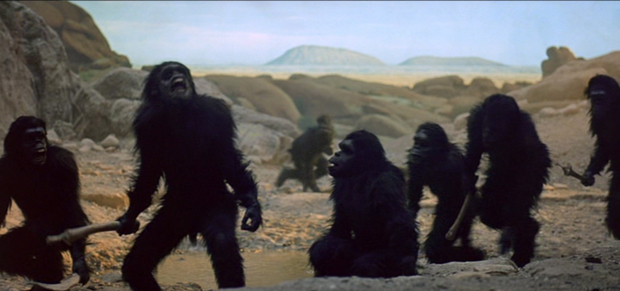
Moonwatcher continues roaring. The whole group advances forward, retaking the area.
104 Medium shot of Moonwatcher alone, the opposing band gone. (19:41)
He throws his bone into the air.
Again, I believe if you examine the exultant Moonwatcher, in the shots below, retaking the waterhole, it may be found he is the same hominid who is playing the leader of the opposing gang in shots 35, 38 and 41. If it isn't the same individual then they were made up to look much the same (just as we will later see in the next section with the pilots of the crafts). It's an expression of twinship, doubling, duality. It's a set-up for the dualities later expressed and their complexity as being a part of a unity. This may not seem like a big idea but it presents some enigmas later. And it also demands the audience rethink their relationship to these two groups so they may re-examine the "why" of their sympathies. There has been really no reason to have a tribal preference, and yet the audience will have naturally sided with the group that had the waterhole taken from them because (a) we seem to have been first acquainted with them, and so (b) we then have sympathy for them when they are overpowered and the waterhole stolen from them. The viewer accepts that group as being, for all intents and purposes, their own tribe because they conceive of them as being the protagonists and we thus feel the waterhole has been illegitimately taken from them, though this is likely a battle that has been repeated many times. We also then side with Moonwatcher's group because they are the ones who have the revelation via the monolith and learn to utilize natural tools as weaponry.
Shot 91 | Shot 92 |
 |  |
Shot 93 | Shot 94 |
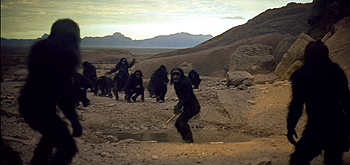 |  |
Shot 95 | Shot 96 |
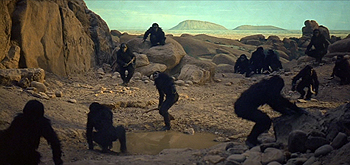 |  |
Shot 97 | Shot 98 |
 |  |
Shot 99 | Shot 100 |
 | 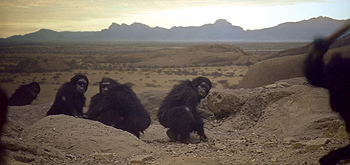 |
Shot 101 | Shot 102 |
 |  |
Shot 103 | Shot 104 |
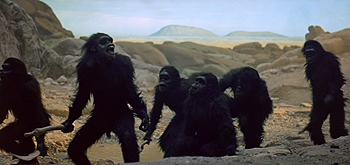 |  |
105 Close-up of the bone rising in the blue sky. (19:46)
It soars up against a cloud.
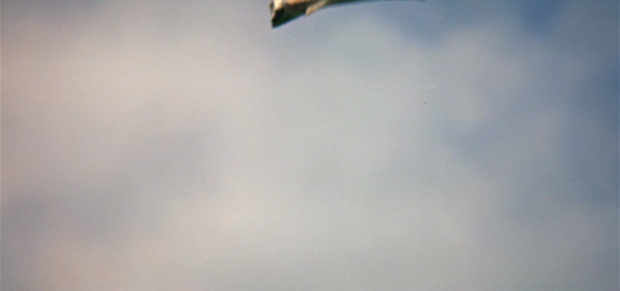
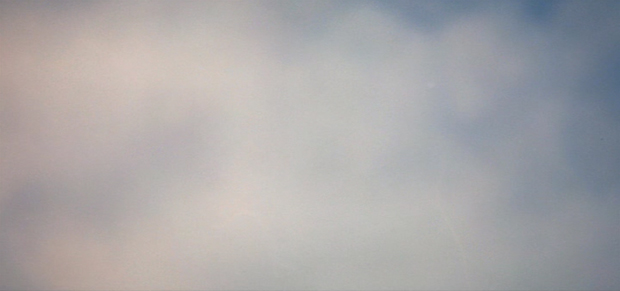
105a A brief break, the bone out of sight, the clouds change, and the camera moves up to catch the bone as it then quits its ascent and begins falling back to earth. (19:48)
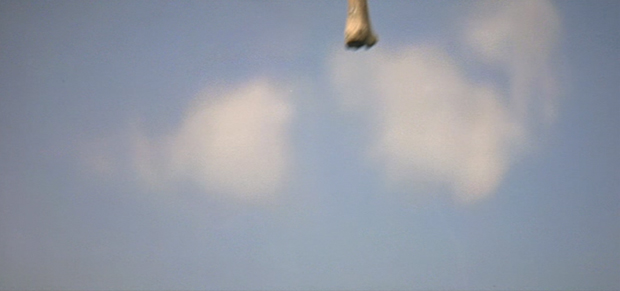
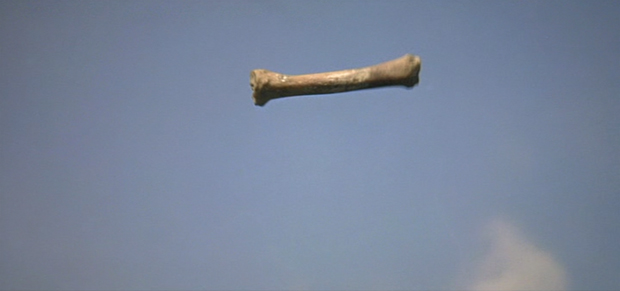
Why two different shots of something so simple? The bone, rising, revolves counter-clockwise. We have the brief break and then when we return to the bone still ascending it is moving clockwise, then continues in a clockwise revolution as it falls. This takes us back to shot 55, when the monolith first appears, and we have the flip-horizontal of the front screen projection. Kubrick will be playing with mirroring, symmetry, balance and counter-balance, clockwise and counter-clockwise orientations through the reminder of the film.
There's a reason I'm counting this shot as 105 and 105a as opposed to 105 and 106. When we reach the end of the third section we'll learn why.
The convergance above the monolith did not happen, at least not physically.
Approx 9300 words or 18 and 1/2 single-spaced pages. A 70 minute read at 130 wpm.
Return to the top of the page.
Next: Part two
Return to Table of Contents for "2001: A Space Odyssey" analysis
Link to the main film page for all the analyses